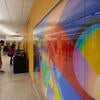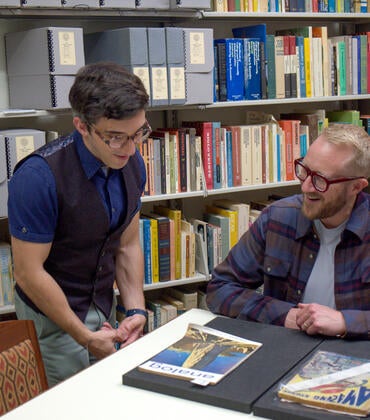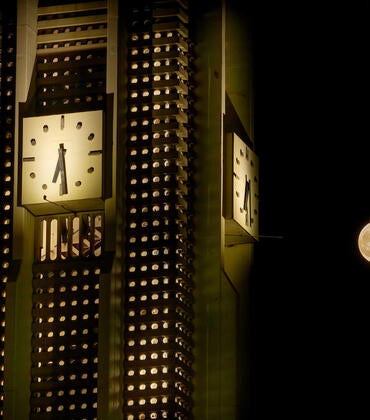A leading figure in Southern California’s modernist movement, painter Stanton Macdonald-Wright often incorporated cross-cultural influences in his colorful, abstract murals.
One of those paintings has now found a home at UC Riverside at the Tomás Rivera Library. The large mural, painted in 1970 and titled “Diaspora,” is a good fit for the diverse campus, reflecting the artist’s themes, said Jason Weems, an associate professor and chair of the History of Art department.
Weems, who was instrumental in bringing the painting to the campus, called it a significant achievement for the campus to receive an important piece of work by an artist of Macdonald-Wright’s stature.
“A major acquisition like this, displayed prominently as it is, signals a new kind of commitment by UCR to bringing the arts into the very fabric of university life,” he said.
The mural is comprised of six panels, measuring a total of 70 by 288 inches. It was installed on the first floor of the library in January. The painting was completed only a few years before the artist’s death in 1973 at the age of 83.
MacDonald-Wright grew up in Southern California and studied art in Paris and New York during the early 20th century. He created a movement known as Synchronism that used abstract shapes and color as a symphony, thinking of it in relationship to music. He returned to Los Angeles in 1919, where he became an early pioneer of abstract and modernist art, Weems said.
Macdonald-Wright oversaw the creation of many Southern California murals as regional head of the federal Works Progress Administration from 1935 to 1942. Later, he taught art at colleges including UCLA and University of Southern California.
His deep influence in the region and advocacy of modernism through teaching and lecturing are among the factors that led to the painting being gifted to UCR.
After the death of Macdonald-Wright’s wife, the estate began the process of distributing his paintings. The executor of the estate, Ilene Fort, a curator emeritus at Los County Museum of Arts, or LACMA, felt it important that his works be distributed equitably among Southern California institutions, Weems said.
He began conversations with her in summer 2019, discussing which piece would be best suited for the campus. The process was delayed due to the pandemic, but the estate eventually offered “Diaspora” to UCR.
Weems said the campus considered other locations but felt the Rivera library was the best choice as a central spot that students, faculty, and staff members pass through daily.
“Art has incredible power to inspire creative thinking, but it can only exercise that power if people actually see it,” Weems said. “I think Rivera is a fantastic place for that.”
University Librarian Steven Mandeville-Gamble welcomed the addition of the painting to the Rivera Library, which is also home to the Eaton Science Fiction Collection along with the campus’ humanities, arts, and social sciences collections.
“The Rivera Library has long served as a locus of exploration of life in the 20th and 21st centuries,” he said. “Macdonald-Wright’s ‘Diaspora’ serves as powerful voice for exploring the human condition in an increasingly complex world in line with the deep explorations of these themes that the Rivera Library has a proud history of fostering.”
In addition to providing passersby an opportunity to reflect on and be inspired by the mural, Weems said it will be valuable for students learning about art history.
Lily Allen, a fourth-year graduate student who is pursuing a doctorate in art history with a focus on American artists, wrote the explanatory text posted next to the mural. Macdonald-Wright is one of the artists featured in her dissertation.
The display of the mural at the library makes an important piece of art history accessible to students, faculty, and staff, she said.
“Seeing art live in person is so important,” Allen said. “It’s so great to have this on campus where anyone can have this live experience with a really important piece of art.”




